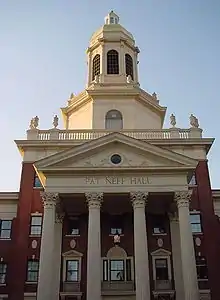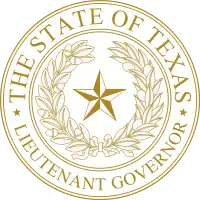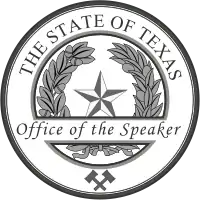Pat Morris Neff
Pat Morris Neff (November 26, 1871 – January 20, 1952) was an American politician, educator and administrator, and the 28th Governor of Texas from 1921 to 1925, ninth President of Baylor University from 1932 to 1947, and twenty-fifth president of the Southern Baptist Convention from 1944 to 1946.
Pat Morris Neff | |
|---|---|
 | |
| 28th Governor of Texas | |
| In office January 18, 1921 – January 20, 1925 | |
| Lieutenant | Lynch Davidson Thomas Whitfield Davidson |
| Preceded by | William P. Hobby |
| Succeeded by | Miriam A. Ferguson |
| Texas Railroad Commissioner | |
| In office 1929–1932 | |
| Succeeded by | Ernest O. Thompson |
| Member of the Texas House of Representatives from the 68th District | |
| In office January 13, 1903 – January 10, 1905 | |
| Preceded by | John Hemphill |
| Succeeded by | George W. Barcus |
| Member of the Texas House of Representatives from the 66th District | |
| In office January 10, 1899 – January 13, 1903 | |
| Preceded by | James Sluder |
| Succeeded by | Edward English |
| Personal details | |
| Born | November 26, 1871 Coryell County, Texas, U.S. |
| Died | January 20, 1952 (aged 80) Waco, Texas, U.S. |
| Resting place | Oakwood Cemetery |
| Political party | Democratic |
| Spouse(s) | Myrtle Mainer Neff |
| Children | Hallie Maude Neff Wilcox, Pat M. Neff, Jr. |
| Alma mater |
|
| Profession |
|
| Southern Baptists |
|---|
Early life
Born on his family ranch near the Eagle Springs community in Coryell County, Texas, to Isabella Neff and her husband, Pat Neff grew up in a rural area and attended local schools. He graduated from McGregor High School. He received his bachelor's degree from Baylor University in Waco.
He worked for the next two years teaching at Southwestern Academy in Magnolia, Arkansas, to earn money to go to law school. Among his students was Harvey C. Couch, who would later become a successful entrepreneur in Arkansas.
Upon returning to Texas, Neff studied and received his law degree from the University of Texas School of Law in Austin. There, he developed a close friendship with Tom Connally and Morris Sheppard of Texas, who both became politicians and were later elected as US Senators from the state.
After receiving his law degree and passing the bar, on May 31, 1899, Neff married Baylor classmate Myrtle Mainer in her hometown of Lovelady. In 1901, they had a daughter, whom they named Hallie Maude. They also had a son, Pat M. Neff, Jr.
He joined the Democratic Party and entered politics, being elected in 1898 to the Texas House of Representatives, and serving from 1899 to 1905. He was elected to one term as Speaker. After returning to his law practice in Waco, Neff served for six years as the assistant county attorney and then as county attorney for McLennan County.
Public office in Texas
Considered a progressive Democrat, Neff defeated former U.S. Senator Joseph Weldon Bailey, a former populist, in the party primary for governor in 1920. This defeat effectively ended Bailey's political career. Neff handily won the general election and started his term in 1921.
Neff was a strong supporter of prohibition. He was instrumental in the development of the Texas State Parks Board. Neff and his mother, Isabella Neff, donated the land which would become the first state park in Texas. It was named Mother Neff State Park. During the resurgence of the Ku Klux Klan during his administration, Neff was criticized for not taking a stronger stance. Neff is notable for his pardon of folk singer Lead Belly in his last days as governor.
In 1921, the West Texas Chamber of Commerce supported legislation passed by both houses of the Texas Legislature to establish a West Texas A&M College. The bill was vetoed by Governor Neff, who said that the state could not afford another state college designed for thinly populated West Texas. He defended his veto, saying that the proposed college had not been included in the 1920 Democratic state platform. Neff's veto stirred up a political firestorm. Two years later he was prepared to sign similar legislation for a college in West Texas; it was co-authored by State Senator William H. Bledsoe of Lubbock. The legislature appropriated $1 million to establish what is now known as Texas Tech University.
Neff was reelected in 1922 but did not seek a third term in 1924. At the time, it was "understood" that no governor should run for a third term, although Texas did not have official term limits for the office.
In 1924 Miriam Wallace "Ma" Ferguson, wife of controversial former Governor James E. Ferguson, won the general election. The Republican nominee, George C. Butte, an American jurist who had opposed James Ferguson's line item veto of the 1917 University of Texas appropriations bill, had a stronger than usual showing. Many voters crossed party lines to vote for him, as they were unhappy with the corruption associated with "Pa" Ferguson.
After leaving the governorship, Neff served on the Texas Railroad Commission. Governor Ross Sterling appointed Ernest O. Thompson of Amarillo to succeed Neff when he left the position to become President of Baylor University. Thompson served on the panel for thirty-two years and developed a reputation as an expert on petroleum issues.
President of Baylor University
After the death of Samuel Palmer Brooks, Neff was nominated to replace him as President of Baylor University. He resigned the post of President of the Board of Trustees, a position that he had held since it was vacated by B. H. Carroll in 1907, upon the nomination as President. In 1947, Neff was asked to stay on as the President by the staff at Baylor University.


President of the Southern Baptist Convention
Neff was president of the Southern Baptist Convention from 1944 to 1946.
Legacy
Pat Neff Elementary School in Houston and Pat Neff Middle School of San Antonio (Northside Independent School District) are named for Neff, as is Pat Neff Hall at Baylor.
Neff died in Waco and is interred there at Oakwood Cemetery. His papers, including those from his time as governor, are housed in The Texas Collection at Baylor University.
See also
References
- Dorothy Blodgett, Terrell Blodgett, and David L. Scott, The Land, the Law, and the Lord: The Life of Pat Neff (2007).
- Stanley, Mark. "Booze, boomtowns, and burning crosses: The turbulent governorship of Pat M. Neff of Texas, 1921—1925," M.A. thesis, University of North Texas, 2005, 138 pages; AAT 1430156 in PROQUEST
- Neff (Pat Morris) Collection, The Texas Collection, Baylor University
External links
- Pat Morris Neff from the Handbook of Texas Online
- Speeches delivered by Pat M. Neff, Governor of Texas, discussing certain phases of contemplated legislation, hosted by the Portal to Texas History]
- Messages of Pat M. Neff, Governor of Texas to the thirty-seventh legislature, hosted by the Portal to Texas History]
- Baylor University Web Site
- 1933 Baylor University "Roundup" via the Baylor University Libraries Digital Collections
| Party political offices | ||
|---|---|---|
| Preceded by William P. Hobby |
Democratic nominee for Governor of Texas 1920, 1922 |
Succeeded by Miriam A. Ferguson |
| Preceded by W.W. Hamilton |
President of the Southern Baptist Convention 1944–1946 |
Succeeded by Louie D. Newton |
| Texas House of Representatives | ||
| Preceded by James Sluder |
Member of the Texas House of Representatives from District 66 (Waco) 1899–1903 |
Succeeded by Edward English |
| Preceded by John Hemphill |
Member of the Texas House of Representatives from District 68 (Waco) 1903–1905 |
Succeeded by George W. Barcus |
| Political offices | ||
| Preceded by Robert E. Prince |
Speaker of the Texas House of Representatives 1903–1905 |
Succeeded by Francis William Seabury |
| Preceded by William P. Hobby |
Governor of Texas January 18, 1921 – January 20, 1925 |
Succeeded by Miriam A. Ferguson |
| Preceded by Missing |
Texas Railroad Commissioner 1929–1932 |
Succeeded by Ernest O. Thompson |


